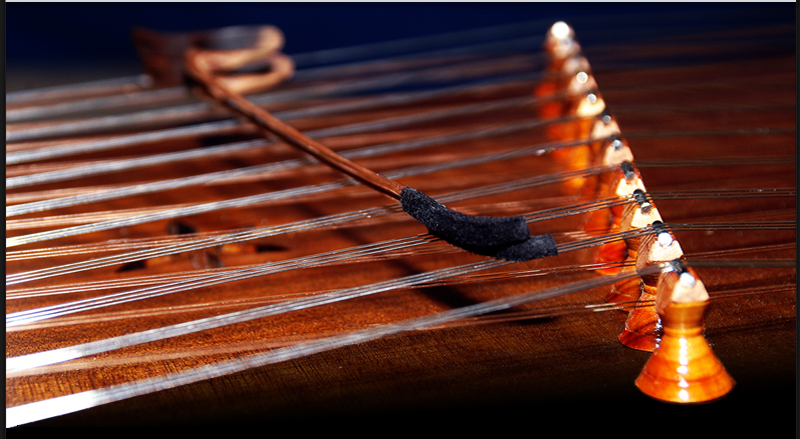The Persian Santour is the original form of the hammered dulcimer. The Hammered dulcimer is ancestor of the Piano. The Original Santour is a diatonic instrument.
The Santur is a three-octave wooden trapezoid-shape instrument with Seventy-two strings which are arranged in eighteen quadruple sets. An adjustable wooden bridge upholds each group of four strings. The four strings over a bridge are tuned to the same pitch. The bass strings are usually made from bronze whereas the strings over the middle bridge are steel.
The resonance box of the traditional instrument is usually made of hard wood, for instance walnut. There are several sound posts inside the box, which connect the table of the instrument to its back. The arrangement of the sound posts plays important role in the sound quality of the instrument. There are two small rosettes on the top panel, which help to amplify the sound.
The Chromatic Santour
(Created by Kourosh Zolani)
While kourosh was a student at the Art University, he invented a new method of tuning the Santour that completely revolutionized the ancient instrument. The original Santour is a diatonic instrument, however with Kourosh's innovative tuning method the Santour is transformed into a chromatic instrument. The Chromatic Santour is the result of several years of intensive study and experiment. Recently Kourosh has evolved his invention to new levels designing a family of chromatic Santours, which further expand the instruments realms of timbre and range.
The resonance box in this instrument has the same shape as the resonance box in the traditional instrument. However it could be the same size or larger than the original one, depending on whether it is a transposing instrument or not.
The Chromatic Santour Family
- The Transposing Instruments
-
- The Chromatic Santour in A, with seventy-two strings and nineteen bridges
- The Chromatic Santour in D, with seventy-two strings and nineteen bridges
- The Chromatic Santour in C#, with seventy-two strings and nineteen bridges
- The Non-transposing Instruments
- The Chromatic Santour with seventy-two strings and nineteen bridges
- The Chromatic Santour with sixty strings and twenty bridges
- The Chromatic Santour with sixty-six strings and twenty-two bridges
Santour-7-Dastgah
(Created by Kourosh Zolani & Mohssen Behrad)
In a santour-7-Dastgah the two main constraints of the original santour have been addressed.
First, in this new instrument, it is possible to change the key on a live stage in few seconds. In a Santour-7-Dastgah the strings lengths are adjustable by means of an added mechanical system to the right and left sides of the trapezoidal box. When the length of the strings is changed, it will vibrate with a different frequency therefore the pitch will be different.
Second, a Santour-7-Dastgah has no tuning pins. This instrument has a totally new and innovative tuning system using specific designed metal bolts and nuts instead of the ancient tuning-pin-in-wood system. Therefore, the tuning in a santour-7-dastgah is very stable. To tune the instrument the musician would use a special supplied wrench, which fits on the tuning nuts.
This new Santour has patent protection in many countries including Iran, USA, Canada and Europe.
For mor information visit:

